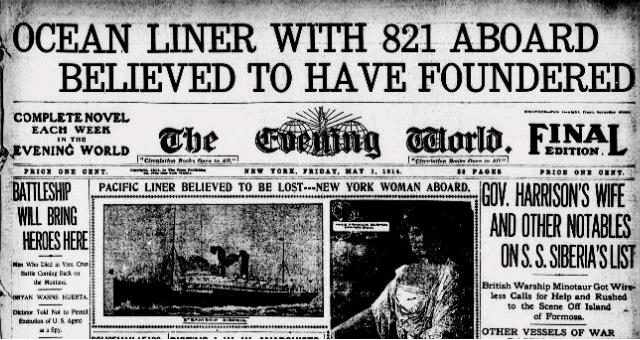 On May 1, 1914, the New York World Herald, along with most other U.S. papers, carried the tragic news of the apparent loss of the 11,000 ton steamer Siberia off the coast of Formosa. The paper reported that the gravest anxiety prevailed over the fate of the 821 souls aboard, including that of Mrs. Francis Burton Harrison, the wife of the Governor General of the Phillipine Islands. Ships from Britain, Japan, and the United States were racing to the scene of the wreck. The ship’s owners, the Pacific Mail Company of San Francisco, spared no expense in dispatching aid.
On May 1, 1914, the New York World Herald, along with most other U.S. papers, carried the tragic news of the apparent loss of the 11,000 ton steamer Siberia off the coast of Formosa. The paper reported that the gravest anxiety prevailed over the fate of the 821 souls aboard, including that of Mrs. Francis Burton Harrison, the wife of the Governor General of the Phillipine Islands. Ships from Britain, Japan, and the United States were racing to the scene of the wreck. The ship’s owners, the Pacific Mail Company of San Francisco, spared no expense in dispatching aid.
The headline of the Seattle Star reported that the ship was “wrecked by Chinese pirates” and helplessly ashore on the coast of Formosa.
On May 2, only an hour behind schedule, and much to everyone’s surprise, the Siberia sailed into Manila harbor none the worse for wear. She hadn’t sunk, nor had she been captured by Chinese pirates. She had been sailing in fair weather the entire time, and her reported demise had been greatly exaggerated.
Apparently the confusion arose when the Siberia made wireless contact and reported her position to the nearby steamer Persia. The Siberia’s call sign was WWU, and the Persia’s call sign was MBS. At some point, the Siberia’s operator was calling the Persia and sent, in International Morse, MBS DE WWU.
This was mistaken for a distress call. In Morse, the Persia’s call MBS is:
_ _ _ . . . . . .
The distress call SOS is:
. . . _ _ _ . . .
The confusion probably arose when the call sign was repeated multiple times:
_ _ _ . . . . . . _ _ _ . . . . . . _ _ _ . . . . . .
The call was overheard by at least one Japanese steamer as well as by the operator of the shore station at Ozesaki, Japan. The Japanese operators mistook it for an SOS. The Siberia probably had a more powerful transmitter than the Japanese stations, and the Japanese operators’ frantic acknowledgements of the distress call were never heard by the Siberia. Instead, the massive rescue effort was dispatched.
In a later report of the incident, the Pacific Mail Company, which was also the owner of the Persia, was quoted as saying that it will probably change the call sign of the Persia.
The Siberia was sold in 1916 to a Japanese line and was renamed the Siberia Maru. She remained in service until 1930 and was scrapped in 1934.
References:
“Wireless Mistake Causes Report of Shipwreck,” Popular Mechanics, July 1914, p. 80
“Marine Insurance Notes”, Pacific Marine Review, June 1914, p. 58.
http://www.atlantictransportline.us/content/48Siberia.htm
